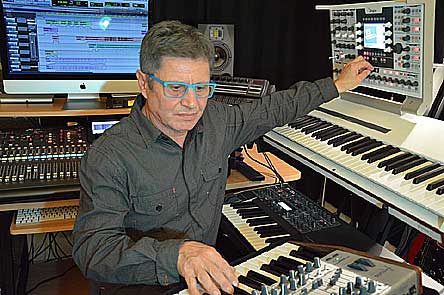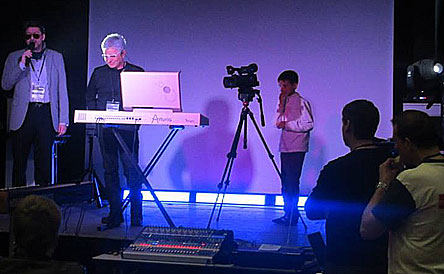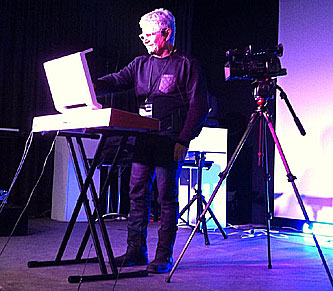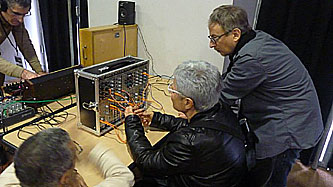 In
2014, the electronic keyboard musician known as Zanov returned,
after a lengthy absence, with an album called Virtual Future. For
those who followed Zanov’s album releases during the 1970s, Virtual
Future was a sonic miracle. Following up Virtual Future, Zanov
is back in 2016 with a new CD of all electronic synthesized sounds
entitled Open Worlds. In the spirit of Virtual
Future, the 2016 CD release of Open Worlds is once again
brimming with electronic soundscapes that inhabits the same sonic
dimension as fellow Frenchman Jean Michel Jarre and German electonic
music pioneers Tangerine Dream. Interestingly, two albums Zanov cites
as big influences on his own sound are T. Dream’s Ricochet
album and the 1975 Pink Floyd album Wish You Were Here. That
stark, labyrinthine scope of Zanov's intensive instrumental electronica
is in full bloom on Open Worlds. Zanov’s background as
a computer engineer comes into play on both of his recent albums and
his high tech sound is again very much in abundance of Open Worlds.
On his latest album, Zanov combines the early analog synthesizer
sounds that—even
in this age of digital synths—he
claims was a disappointment over the original vintage synthesizer
vision. With its myriad of keyboard electronics, the sound of Open
Worlds is beguiling and hypnotic. Following the passing of Tangerine
Dream founder Edgar Froese, it is perhaps up to artists such as Zanov
to carry on the tradition of creating new 21st century electronic
music that holds true to the vision of the original masters. www.zanov.net
In
2014, the electronic keyboard musician known as Zanov returned,
after a lengthy absence, with an album called Virtual Future. For
those who followed Zanov’s album releases during the 1970s, Virtual
Future was a sonic miracle. Following up Virtual Future, Zanov
is back in 2016 with a new CD of all electronic synthesized sounds
entitled Open Worlds. In the spirit of Virtual
Future, the 2016 CD release of Open Worlds is once again
brimming with electronic soundscapes that inhabits the same sonic
dimension as fellow Frenchman Jean Michel Jarre and German electonic
music pioneers Tangerine Dream. Interestingly, two albums Zanov cites
as big influences on his own sound are T. Dream’s Ricochet
album and the 1975 Pink Floyd album Wish You Were Here. That
stark, labyrinthine scope of Zanov's intensive instrumental electronica
is in full bloom on Open Worlds. Zanov’s background as
a computer engineer comes into play on both of his recent albums and
his high tech sound is again very much in abundance of Open Worlds.
On his latest album, Zanov combines the early analog synthesizer
sounds that—even
in this age of digital synths—he
claims was a disappointment over the original vintage synthesizer
vision. With its myriad of keyboard electronics, the sound of Open
Worlds is beguiling and hypnotic. Following the passing of Tangerine
Dream founder Edgar Froese, it is perhaps up to artists such as Zanov
to carry on the tradition of creating new 21st century electronic
music that holds true to the vision of the original masters. www.zanov.net
mwe3.com presents
an interview with
ZANOV
 mwe3:
What were some of the circumstances and new ideas that led to the
2016 CD release of Open Worlds and does it introduce a new
era for the music of Zanov?
mwe3:
What were some of the circumstances and new ideas that led to the
2016 CD release of Open Worlds and does it introduce a new
era for the music of Zanov?
Zanov: Once the link between the past and the future was restored
with the release of Virtual Future, I could start to focus
on the next album in April 2015.
The guidelines I had for this new album:
• To start from many musical and sound ideas I had in mind.
• To create sounds according to my emotions, but also paying
attention to their combination, their evolution and the overall structure.
• To make shorter tracks and to base each track on new ideas
in term of sounds, structure, composition. I thought that the consistency
of the album would be brought by the fact that it came out naturally
from me and this would make my style recognizable enough.
mwe3: Did the positive reaction of Virtual Future inspire
you to create Open Worlds soon after Virtual Future
and how do you compare the sound and vision of both albums?
 Zanov:
Virtual Future was a combination of the past and the present
and a bridge between them. Once the gap has been closed, I was eager
to create a brand new album, it was vital for me.
Zanov:
Virtual Future was a combination of the past and the present
and a bridge between them. Once the gap has been closed, I was eager
to create a brand new album, it was vital for me.
I am doing the music that I feel, not trying to be in any trend.
I am building my own sounds, giving life to them, making them evolve,
combining them, and composing the way I feel. For me a song is a piece
of life with evolution, phases, surprises, order, chaos, emergence,
random events...
This is the same view I had 40 years ago, but there are 2 main differences.
The first one is the time scale. I am making shorter structures and
sounds evolving faster because this is the way I feel it today at
my age.
The second one is in the richness and number of sounds, allowed by
the capability of the new synths and mixing automation.
There is much more sounds and layers, more complex sounds and more
sounds events in Open Worlds than in Virtual Future.
You can hear different things depending on how you are focused when
listening.
 mwe3:
What thoughts were in your head as you prepared to write and record
Open Worlds? What do you think about as you create and record
your music?
mwe3:
What thoughts were in your head as you prepared to write and record
Open Worlds? What do you think about as you create and record
your music?
Zanov: The source is very simple - it is direct sounds... a
combination of sounds. They come to my mind directly at any time,
sometime during the night and I can feel them in my head. So, no thoughts,
just feelings directly from the music.
mwe3: Why do you call your new CD Open Worlds? Does
it mean everything is possible in your music? Electronic music has
always been open to everything!
Zanov: When composing I felt each track as independent from
the others. The tracks had no names until the end of the mixing, only
code names with letters and numbers, found on the fly.
At the end of the mixing, while checking everything many times, I
realized that it was like a journey through 9 different musical worlds,
and the name of the album came to me: Open Worlds.
When calling the album Open Worlds, there was an analogy
between worlds in the cosmos and musical worlds. This means that musical
worlds are as mysterious, surprising, complex, as worlds in the universe
and you guessed it, it means that everything is possible.
mwe3: You were talking about new synthesizers in addition to
the Arturia Origin synth. What synths dominated the sound of Open
Worlds? Are you adding new gear and equipment to your studio sound?
Zanov: I
acquired an Access Virus TI keyboard in addition to the Arturia Origin.
It took me more than a month to dig into the Virus TI to understand
its potential and master it to build my own sounds. This also triggered
new ideas to me.
 I
used equally the Arturia Origin and the Virus TI to compose Open
Worlds. Only one track “Electric Dust Field” was done
with the Arturia Origin only.
I
used equally the Arturia Origin and the Virus TI to compose Open
Worlds. Only one track “Electric Dust Field” was done
with the Arturia Origin only.
With the Arturia Origin, I can do the sounds I was doing with my vintage
synthesizers, except some sounds I was doing with the RMI Harmonic
synth, which were done with “additive” synthesis. The main
difference is in ease of use. The positive thing is that I can store
all my sounds in presets and rework them when I need. The negative
thing is that there are much less knobs and switches to make the sounds
evolve live.
I have chosen these two synthesizers because they have a great flexibility
to connect the modules together, and this is important to me for giving
life to the sounds. The Origin has the graphical interface to connect
the modules and the Virus TI has a Matrix menu, but they both give
access to many parameters.
 mwe3:
What images inspired the artwork of Open Worlds? There are
some very cool looking futuristic images on the CD cover art. It looks
like worlds within worlds!
mwe3:
What images inspired the artwork of Open Worlds? There are
some very cool looking futuristic images on the CD cover art. It looks
like worlds within worlds!
Zanov: I worked with a graphic designer to have images which
represent a trip through other worlds with an aesthetic that reflects
the emotions of my music. There is a contrast between darkness and
bright light, a kind of fractal structure which fits with my music.
mwe3: What else have you been experiencing this past year?
Seems like the world is going through great changes yet we all remain
hopeful. Are you hopeful about the future of man and the future of
music?
Zanov: I have a scientific background and my mind is directed
toward the future. I think that human evolution is driven by the technology,
evolution and scientific discoveries. We can see how the internet
and the mobile phone and the high speed communications are changing
our societies around the world and it is nothing compared to what
it will be in thousands years from now. I would love to be able to
make a trip in the future to see how the world and the worlds will
be in millions years from now. Surely this dream is indirectly reflected
in my music.
 mwe3:
Now that you have released both albums Virtual Future and Open
Worlds over the past year or two, are you feeling ever more prolific
about writing and creating more music and will there be possible live
performances or videos of Zanov music in the future?
mwe3:
Now that you have released both albums Virtual Future and Open
Worlds over the past year or two, are you feeling ever more prolific
about writing and creating more music and will there be possible live
performances or videos of Zanov music in the future?
Zanov: I have still many ideas and sounds and music's in mind,
but now, my plan is to find the right technologies I could use to
play my music live. I do not have enough synthesizers to play, in
concert, all the sounds I have on each of the Open Worlds tracks
and I do not want to have the main parts prerecorded and play only
ten percent on a keyboard. This will not allow me to express myself.
I need at least one more powerful synth and I have to study how to
use Ableton Live in a specific way. I will start working on that in
a couple of months and I am confident that I will find a way for playing
live.
Since 1977 I have been a pioneer in using video, diaporama, dance
and lasers in my concerts. It is mandatory to me to find the right
partners to design the visual parts of the future concerts. I hope
I will succeed in making all that possible.



